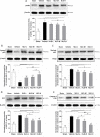Naoling decoction restores cognitive function by inhibiting the neuroinflammatory network in a rat model of Alzheimer's disease
- PMID: 28487495
- PMCID: PMC5522095
- DOI: 10.18632/oncotarget.17337
Naoling decoction restores cognitive function by inhibiting the neuroinflammatory network in a rat model of Alzheimer's disease
Abstract
Neuroinflammation is central to the pathogenesis of Alzheimer's disease (AD). We previously showed that Naoling decoction (NLD), a traditional Chinese medicine, was effective against AD, acting by inhibiting expression of IL-1β and IL-6. In the present study, we generated the rat model of AD by injecting Aβ1-42 peptide intracerebroventricularly and evaluated the dose-dependent effects of NLD treatment. The NLD-treated rats exhibited significant improvements in cognitive function as evaluated by the Morris water maze test. Golgi-Cox staining revealed that NLD treatment dose-dependently increased dendritic spines in the CA1 region, which were diminished in vehicle-treated rats. Further, NLD treatment normalized hippocampal Chromogranin A levels, which were elevated by Aβ1-42 induction. NLD also attenuated activation of microglia and astrocytes induced by Aβ1-42. Subsequently, NLD dose-dependently reduced levels TNF-α, IL-1β and IL-6 by inhibiting the NF-κB signaling pathway and the ASC-dependent inflammasome in the hippocampus. These findings reveal that NLD is a promising therapeutic agent that exerts inhibitory effects at multiple sites within the neuroinflammatory network induced in AD.
Keywords: Alzheimer’s disease; Chromogranin A; Naoling decoction; amyloid-beta (Aβ) deposits; neuroinflammatory network.
Conflict of interest statement
The authors declare no conflicts of interest.
Figures








Similar articles
-
Effect of Naoling decoction on the expression of microglia and IL-6 in hippocampal CA3 region of rats with synthetic Alzheimer's disease.Zhong Nan Da Xue Xue Bao Yi Xue Ban. 2013 Feb;38(2):113-9. doi: 10.3969/j.issn.1672-7347.2013.02.001. Zhong Nan Da Xue Xue Bao Yi Xue Ban. 2013. PMID: 23456069
-
Huannao Yicong Decoction () extract reduces inflammation and cell apoptosis in Aβ1-42-induced Alzheimer's disease model of rats.Chin J Integr Med. 2017 Sep;23(9):672-680. doi: 10.1007/s11655-016-2255-1. Epub 2016 Mar 29. Chin J Integr Med. 2017. PMID: 27022730
-
Safflower yellow attenuates learning and memory deficits in amyloid β-induced Alzheimer's disease rats by inhibiting neuroglia cell activation and inflammatory signaling pathways.Metab Brain Dis. 2019 Jun;34(3):927-939. doi: 10.1007/s11011-019-00398-0. Epub 2019 Mar 4. Metab Brain Dis. 2019. PMID: 30830599
-
Neuroprotective effects of Tongmai Yizhi Decoction () against Alzheimer's disease through attenuating cyclin-dependent kinase-5 expression.Chin J Integr Med. 2017 Feb;23(2):132-137. doi: 10.1007/s11655-016-2507-0. Epub 2016 Jul 9. Chin J Integr Med. 2017. PMID: 27392479
-
Anti-inflammatory and cognitive effects of interferon-β1a (IFNβ1a) in a rat model of Alzheimer's disease.J Neuroinflammation. 2019 Feb 18;16(1):44. doi: 10.1186/s12974-019-1417-4. J Neuroinflammation. 2019. PMID: 30777084 Free PMC article.
Cited by
-
Naringin Dihydrochalcone Ameliorates Cognitive Deficits and Neuropathology in APP/PS1 Transgenic Mice.Front Aging Neurosci. 2018 Jun 5;10:169. doi: 10.3389/fnagi.2018.00169. eCollection 2018. Front Aging Neurosci. 2018. PMID: 29922152 Free PMC article.
-
Integrated Metabolomic and Lipidomic Analysis Reveals the Neuroprotective Mechanisms of Bushen Tiansui Formula in an Aβ1-42-Induced Rat Model of Alzheimer's Disease.Oxid Med Cell Longev. 2020 Jun 19;2020:5243453. doi: 10.1155/2020/5243453. eCollection 2020. Oxid Med Cell Longev. 2020. PMID: 32655770 Free PMC article.
-
Identifying circRNA-associated-ceRNA networks in the hippocampus of Aβ1-42-induced Alzheimer's disease-like rats using microarray analysis.Aging (Albany NY). 2018 Apr 27;10(4):775-788. doi: 10.18632/aging.101427. Aging (Albany NY). 2018. PMID: 29706607 Free PMC article.
-
Identification of Multi-Target Anti-AD Chemical Constituents From Traditional Chinese Medicine Formulae by Integrating Virtual Screening and In Vitro Validation.Front Pharmacol. 2021 Jul 16;12:709607. doi: 10.3389/fphar.2021.709607. eCollection 2021. Front Pharmacol. 2021. PMID: 34335272 Free PMC article.
-
The seed oil of Paeonia ludlowii ameliorates Aβ25-35-induced Alzheimer's disease in rats.Food Sci Nutr. 2021 Mar 30;9(5):2402-2413. doi: 10.1002/fsn3.2102. eCollection 2021 May. Food Sci Nutr. 2021. PMID: 34026059 Free PMC article.
References
-
- Ritchie CW, Molinuevo JL, Truyen L, Satlin A, Van der Geyten S, Lovestone S. Development of interventions for the secondary prevention of Alzheimer's dementia: the European Prevention of Alzheimer's Dementia (EPAD) project. The Lancet Psychiatry. 2016;3:179–86. doi: 10.1016/s2215-0366(15)00454-x. - DOI - PubMed
MeSH terms
Substances
LinkOut - more resources
Full Text Sources
Other Literature Sources
Medical
Research Materials
Miscellaneous

